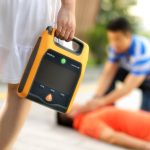What is a dust storm?
Dust storms are natural events. They occur when strong, hot, dry winds blow dust and soil into the air.
The wind moves the dust across the country, often for many kilometres. These storms are more likely to occur in the summer and after a period of drought. This is when the land is warmer and the soil is more exposed.
Because Australia has large areas of desert, dust storms are more common here. Periods of drought can increase the chance of a major dust storm.
A dust storm reduces the quality of the air. Particles picked up during a dust storm include:
- dust
- soil
- sand
- microorganisms like bacteria
- fungi spores
We should all take care in a dust storm. People with respiratory (breathing) conditions may need to take special care.
How can dust storms affect my health?
Health problems can develop if you breathe in the dust from the storm. The health effects of a dust storm can depend on:
- the size of the dust particles
- what the dust particles are made from
- whether you have any underlying medical conditions
- how long you’re exposed to the dust storm
The health impacts of dust can vary. It may cause:
- itchy or burning eyes
- throat irritation
- nose irritation
- coughing or sneezing
- skin irritation
These can often be eased by washing the area well with water.
Continued exposure to airborne dust can lead to:
- chronic breathing and lung problems
- possibly heart disease
Size of the dust particles
Dust particles vary in size. They can be:
- coarse — non-inhalable
- fine — inhalable
- very fine — respirable
Coarse dust particles usually only irritate your eyes and upper airways (your nose, mouth and throat). In most people, these particles do not cause health problems. This is because they are too big to move into the lower airways.
However, fine and very fine dust particles, can get deep into your lungs and cause irritation and inflammation. This can cause problems with breathing, especially if you already have a health issue — such as asthma or emphysema.
Health conditions
For some people, breathing in the dust from a dust storm can:
- cause an allergic reaction
- cause an asthma attack
- cause other serious breathing problems
- lead to cardiovascular (heart-related) problems
- lead to a reduced life span
The longer you are exposed to the dust, the more chance that it will affect you. Breathing dust for a long time can lead to long-term breathing, heart or lung problems.
Am I at risk from a dust storm?
Those most at risk of health problems from a dust storm are:
- babies, children and teenagers
- people over 65 years
- pregnant people
- people who have breathing disorders such as asthma and chronic obstructive pulmonary disorder (including chronic bronchitis and emphysema)
- people with a cardiovascular (heart-related) condition
- people with diabetes
When should I see my doctor?
You should follow your prescribed treatment plan if you have asthma or another chronic respiratory condition and you have:
- chest tightness
- wheezing
- coughing
- shortness of breath
If the symptoms don’t get better, you should see your doctor.
You should also see your doctor if you have a pre-existing heart or other chronic condition and:
- you have breathing problems
- your symptoms get worse
What precautions can I take during a dust storm?
During a dust storm, the following advice can help reduce the effects of a dust storm on your health.
- Stay indoors — close the windows and doors.
- If possible, stay in an air-conditioned room and set your air conditioner to recirculate the indoor air.
- Cover your nose and mouth with a mask or damp cloth.
- Avoid vigorous exercise.
- Avoid outdoor activity.
You can buy P2, P3, KN95 or N95 masks in hardware stores. If your mask is fitted correctly over your nose and mouth it should block even the finest particles. Surgical masks don’t prevent dust from being breathed in.
If the dust is getting into your house, you could visit a local air-conditioned building such as:
- a library
- a community centre
- a shopping centre
Asthma symptoms and dust storms
If you have asthma or another lung condition you may develop symptoms during a dust storm. These symptoms can include:
- shortness of breath
- coughing
- wheezing
- chest pain
If this happens, you should:
- take your preventer medicine
- stick to your asthma action plan or other treatment plan
If you don’t have an action plan, consider taking 4 to 6 puffs of your reliever inhaler (usually blue or grey).
Always try to use your inhaler with a spacer as they are much more effective this way.
If your symptoms don’t improve get medical advice.
Driving in a dust storm
Visibility drops very quickly during a dust storm.
If you’re caught in a dust storm while driving, you should reduce your speed and turn on your headlights.
If you can’t see ahead of you clearly, slow down. Be prepared to pull over and stop if visibility is less than 100 metres (very low). But don’t stop under trees.
If your car is air-conditioned switch the air intake to ‘recirculate’. This will reduce the amount of dust getting into your car.


